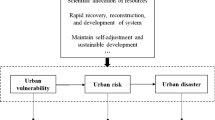Abstract
Studying the carrying capacity of resources and environment of city clusters in the central China has important practical guidance significance for promoting the healthy, sustainable and stable development of this region. According to their influencing factors and reciprocity mechanism, using system dynamics approaches, this paper built a SD model for measuring the carrying capacity of resources and environment of the city clusters in the central China, and through setting different development models, the comprehensive measurement analysis on the carrying capacity was carried out. The results show that the model of promoting socio-economic development under the protection of resources and environment is the optimal model for promoting the harmony development of resources, environment, society and economy in the city clusters. According to this model, the optimum population scale of the city clusters in 2020 is 42.80×106 persons, and the moderate economic development scale is 22.055×1012 yuan (RMB). In 1996–2020 the carrying capacity of resources and environment in the city clusters took on obvious phase-change characteristics. During the studied period, it is basically at the initial development stage, and will come through the development process from slow development to speedup development.
Similar content being viewed by others
References
Chen Hong, Hui Yanbin, 2007. Analysis on the water resources carrying capacity of the city group in central and southern part of Liaoning Province. Sci-Tech Information Development & Economy, 17(10): 158–160. (in Chinese)
Cohen J E, 1995. How Many People Can the Earth Support? New York: W.W. Norton & Co.
Cui Xinhua, Guo zhouting, Wang Xiaopei et al., 2007. Henan Water Resources Bulletin (1996–2006). Zhengzhou: Henan Water Resources Department.
Daily G C, Ehrlich P R, 1992. Population, sustainability, and earth’s carrying capacity: A framework for estimating population sizes and lifestyles that could be sustained without undermining future generations. BioScience, 42: 761–771.
Dhondt A A, 1988. Carrying capacity: A confusing concept. Acta Oecologica/Oceologia Generalis, 9(4): 337–346.
Editorial Board of Henan City Statistical Yearbook, 1997–2007. Henan City Statistical Yearbook (1996–2006). Beijing: China Statistics Press.
Fang Chuanglin, Bao Chao, Zhang Chuanguo, 2003. Analysis on the changing condition and the evolutive scene of the ecology-production-living carrying capacity in arid area: A case study in Yuli District in the lower reaches of Tarim River. Acta Ecologica Sinica, 23(9): 1915–1923. (in Chinese)
Fang Chuanglin, Lin Xueqin, 2009. The eco-environmental guarantee for China’s urbanization process. Journal of Geographical Sciences, 19(1): 95–106. DOI: 10.1007/s11442-009-0095-z
Fang Chuanglin, Song Jitao, Zhang Qiang et al., 2005. The formation, development and spatial heterogeneity patterns for the structures system of urban agglomerations in China. Acta Geographica Sinica, 60(5): 27–840. (in Chinese)
Feng Zhiming, Liu Dengwei, 2006. A study on water resources carrying capacity in Jingjinji region. Journal of Natural Resources, 21(5): 89–699. (in Chinese)
Graymore M, 2005. Journey to Sustainability: Small Regions, Sustainable Carrying Capacity and Sustainability Assessment Methods. Griffith: Griffith University.
Hardin G., 1986. Cultural carrying capacity: A biological approach to human problems. BioScience, 36(9): 599–606.
Henan Environmental Monitoring Center Station, 2001. The Quality Report of Henan Province’s Environment (1996–2000). Zhengzhou: Henan Environmental Protection Agency.
Henan Environmental Monitoring Center Station, 2006. The Quality Report of Henan Province’s Environment (2001–2005). Zhengzhou: Henan Environmental Protection Agency.
Henan Environmental Monitoring Center Station, 2007. The Quality Report of Henan Province’s Environment (2006). Zhengzhou: Henan Environmental Protection Agency.
Henan Environmental Monitoring Center Station, 2007. The Compendium of Environment Statistics of Henan Province (1996–2006). Zhengzhou: Henan Environmental Protection Agency.
Liu Xiaoli, 2009. Study on Carrying Capacity of Resources and Environment of City Clusters. Beijing: Institute of Geographic Sciences and Natural Resources Research, Chinese Academy of Sciences.
Liu Xiaoli, Fang Chuanglin, 2008. Progress and prospect of study on carrying capacity of resource and environment of city clusters. Progress in Geography, 27(5): 5–42. (in Chinese)
Liu Xiaoli, Fang Chuanglin, Wang Fazeng, 2008. Study on spatial combination characters and conformity patterns of the Central Plain city cluster. Geographical Research, 27(2): 409–420. (in Chinese)
Lu Bin, 2007. Synthesis Report for the Study on the Carrying Capacity of Chinese Cities and Its Crisis Management. Beijing: Science Press.
Malthus T R, 1798. An Essay on the Principle of Population. London: Pickering.
Meyer P S, Ausubel J H, 1999. Carrying capacity: A model with logistically varying limits. Technological Forecasting and Social Change, 61(3): 209–214.
National Land Agency of Henan Province, 2007. The Report of Land and Resources of Henan Province (1996–2006). Zhengzhou: Henan Environmental Protection Agency.
Odum E P, 1953. Fundamentals of Ecology. Philadelphia: W. B. Saunders.
Price D, 1999. Carrying capacity reconsidered. Population and Environment, 21(1): 5–26.
Seidl I Tisdell, 1999. Carrying capacity reconsidered: From Malthus’ population theory to cultural carrying capacity. Ecological Economics, 31: 395–408.
Sleeser M, 1990. Enhancement of Carrying Capacity Options ECCO. London: the Resource Use Institute.
Tan Jiaqing, Sun Xihua, Li Yujiang, 2007. Research on relative carrying capacity of resources and competitiveness in city group of Shandong Peninsula. Resource Development & Market, 23(3): 196–198, 206. (in Chinese)
Verhulst P F, 1838. Notice sur la loi que la population suit dans son accroissement. Corresponding Mathematical Physiology, 10: 113–121.
Zhou Chun, Shu Tingfei, Wu Renhai, 2003. A study of carrying capacity of land resources in Pearl River Delta. Management Geological Science and Technology, (6): 16–19. (in Chinese)
Author information
Authors and Affiliations
Corresponding author
Additional information
Foundation item: Under the auspices of National Natural Science Foundation of China (No. 40971101), Major Project of 11th Five-Year Scientific and Technological Support Plan of China (No. 2006BAJ14B03)
Rights and permissions
About this article
Cite this article
Fang, C., Liu, X. Comprehensive measurement for carrying capacity of resources and environment of city clusters in central China. Chin. Geogr. Sci. 20, 281–288 (2010). https://doi.org/10.1007/s11769-010-0281-z
Received:
Accepted:
Published:
Issue Date:
DOI: https://doi.org/10.1007/s11769-010-0281-z




